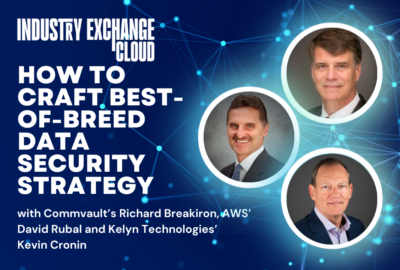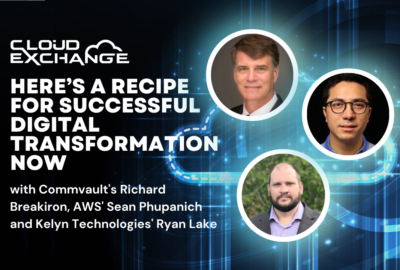Insight by Commvault, AWS and Kelyn Technologies
Industry Exchange Data 2024: Commvault, AWS and Kelyn experts on tuning up CX through smart data management
Modern applications that bring convenience to users require modernizing infrastructure to optimize data management, resilience and elasticity, panelists say.
Improving citizen or customer experience requires significant modernization of the systems that support digital services. If agencies consider convenience to the customer as a measure of better CX, then convenience should also improve for the agency’s own business owners and IT staff.
That’s according to Richard Breakiron, senior director for strategic initiatives for the Americas public sector at Commvault.
“Convenience isn’t only for the end customer. Behind the scenes, there are a lot of things that have been done to optimize the operation of a capability,” he said during Federal News Network’s Industry Exchange Data 2024.
For example, operations such as maneuvering workloads to, from and among clouds, and orchestrating cloud and on-premise data center operations rank among candidates for automating, he said.
Added Kevin Cronin, co-founder and president of Kelyn Technologies: “Really, what you need to do is step back, take time, gather your thoughts and put together a really good plan on how you can utilize the technologies that are in the cloud that present you opportunities to make things more efficient.”
That transformation of the backend establishes the foundation for improved CX.
“When you make things more efficient, you end up with a happier set of customers, and the convenience factor goes through the roof,” Cronin said.
Do an outside-in analysis of your digital experience
In any CX-focused, data-centric modernization, it’s wise to view applications from the outside in — that is, from the point of view of the ultimate user, said David Rubal, head of U.S. federal business development for AWS storage, part of Amazon Web Services. Then the agency can more effectively design an infrastructure to support the application needs.
“Especially around government, you have to work backward from the capability of the requirements to actually ensure that what’s being developed aligns,” Rubal said. “That applies to the full stack — everything from the network infrastructure up through the application and then the user experience.”
Modernization in service of CX “really comes down to getting to the point where operational consistency is an objective,” Rubal added.
The objective of operational consistency must apply throughout an agency’s infrastructure, “however the technology is instantiated,” he said. Whether in the data center, in a commercial cloud, in an edge computing facility with limited bandwidth, “you want that same operational consistency so that when you create processes, it’s the same experience from edge to cloud, and cloud to edge.”
Cronin said Kelyn tries to integrate Commvault capabilities in data management, backup and resiliency and integrate it with AWS storage.
“We created a process for making sure that the outcome is the same across the board, whether it’s an on-prem customer, an AWS customer or a hybrid customer,” he said.
Along with operational efficiency, modernization must include an updated strategy for data, Breakiron said. “Data is that lifeblood today,” he said.
Securing it becomes especially important because applications, in contemporary digital services, expose data to external users.
“More than ever, the federal government is looking to try and interface with its citizenry and make itself transparent,” Breakiron said. Agencies “want to expose the data. And yet they need to make sure that the data is secure, that it’s not corrupted, that it doesn’t put agencies at risk when they let a public portal be open.”
Make data plan central part of your modernization strategy
The modernization strategy must encompass data storage, access and backup, Cronin said. “You need a really good plan to make sure, if you’re going to have a backup in a different location or a recovery point, that all of the data is there,” he said. “You need to test it. You need to make sure that the architecture that you’ve designed works.”
Breakiron emphasized the need to not underestimate the complexity at the back end, so users have a seamless and intuitive experience at the front end of an application.
In the goal of easy self-service, “it’s got to be very user-friendly, it’s got to be very, very intuitive,” Breakiron said. “And the complexity to do that behind the scenes goes up exponentially the easier you want to make that interface.”
He added that a classic engineering premise still applies to managing that complexity.
“You will only be able to manage the complexity if you break down the storage plane, from the data management plane, from the control plane,” Breakiron said. “By separating those out, you get enormous convenience and greater security because now you can build security in at appropriate levels based on who the user is.”
In short, modernizing should incorporate the notions of elasticity, flexibility and automation, Rubal said. “That allows you to achieve the mission capabilities and mission faster in a more operationally consistent way.”
Discover more tips and advices shared during Industry Exchange Data 2024 now.
Copyright © 2024 Federal News Network. All rights reserved. This website is not intended for users located within the European Economic Area.
Tom Temin is host of the Federal Drive and has been providing insight on federal technology and management issues for more than 30 years.
Follow @tteminWFED






